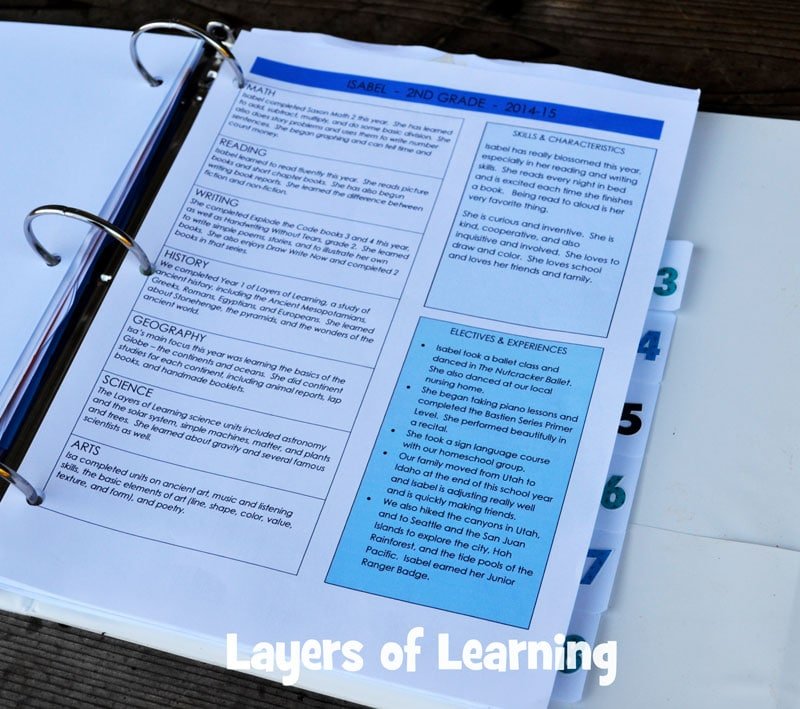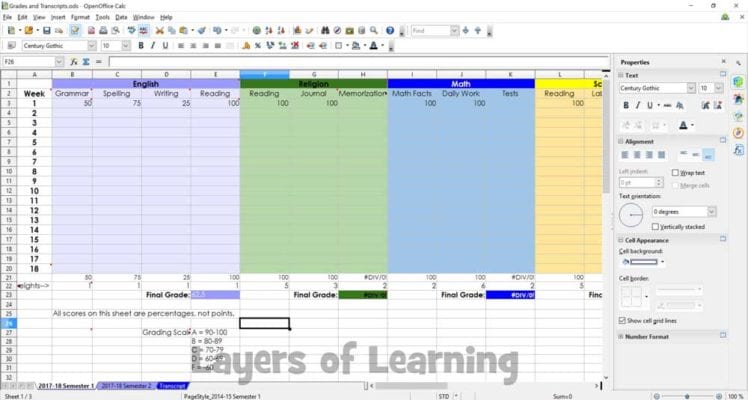
Making a homeschool portfolio is one of the easiest ways to track and record kids’ progress in school. Before we get into it much further though, I want to encourage you to find out the laws and requirements in your state or country. You also need to be aware of requirements for any charter school or other organization you’re a part of or get funding from. I am not funded by anyone and live in Idaho (where there aren’t record-keeping requirements of homeschoolers). Nonetheless, I keep portfolios for all of my kids, and transcripts once they reach high school age.
In addition to what I suggest, you may need to track attendance days, instructional hours, keep an IEP, record testing scores, or show other proof of courses completed depending on your location and situation. Make sure that you keep adequate records to be within the law.
How I Build A Homeschool Portfolio
Our school year is rolling down to its end and once again, I’m faced with piles and piles of paperwork. I wish I could just feel proud of all the good work we’ve accomplished, but I’m too overwhelmed by what to do with it all to be proud!
Even if your state doesn’t require it, I think it’s good practice to keep a homeschool portfolio, but if I kept everything, I’d have to rent a storage unit for it all.
When you’re putting together your portfolio, keep these three principles in mind:
- More is not better, it’s just more.
- Your goal is to show progress.
- Make it a cool keepsake.
Now, get the trash bag out and let’s sort out just what you should {and shouldn’t} keep.

A Homeschool Resume
Before you even start sorting, you’re going to make a one-page summary page of your kid’s work. Treat it a bit like a resume. Tell about what he or she has completed, what skills have been acquired, and what’s been mastered. You can include school subjects, life skills, personal and social skills, and extracurricular activities.


Recording in this way will set you free! If your resume indicates they’ve completed Saxon Math 6/7, you no longer need to keep every math assignment. There is no need to keep every worksheet, cursive practice sheet, and spelling list. Toss them.
I print out my kids’ report cards on the backside of the resume, so it becomes one double-sided sheet with lots of information. I also give them a copy of their report card. The report cards are mostly encouragement tools in our homeschool. I write down the growth I’ve seen in them and use it as a kudos – an encouragement tool that helps them see their accomplishments.
The Best of the Best
Go through all the assignments and choose no more than three that are the best of the best from the year.

If you choose three every single year, you’ll have kept 39 samples throughout their school years. That’s a lot! Be ruthless. It’s okay to just keep one or two a year, but definitely no more than three. I like to choose at least one writing assignment that included their handwriting, just because I love watching how it evolves over the years and seeing those cute little scrawls brings back a world of memories and warmth to me.
Our only exception to this rule is that we have one shelf where we keep really great finished books my kids have done. They certainly don’t turn all of their writing into books, but when they do make homemade books, we keep those on the shelf with all the other books we own. The kids love reading books they’ve written. It’s not part of their portfolio, but it is part of our family library.
Take Pictures of the Fun
Much of what we do in our hands-on homeschool is projects. It’s impossible to keep all those science experiments, book projects, history posters, shoebox dioramas, and 3-D maps we create. They are some of our best, most memorable work, but they don’t work well in a portfolio, so we take pictures instead. Make a few pages that showcase the explorations, expeditions, and experiments you’ve done over the year. I just make a collage page and print it out.
Include captions or a brief description along with the pictures. You can print it out on card stock or on photo paper. Limit yourself to one history page, one geography page, one science page, and one art page. If you have some pictures from other subjects, combine all of them on to one page as well.

Reading Log
Finally, include a reading log of the books they’ve read during the year. We keep this all year long as we go, so it’s easy to just include that page behind the others.
What A Ten-Page Homeschool Portfolio Looks Like
Page 1: Resume
Pages 2, 3, 4: Three of the best assignments, including at least one handwritten one (It’s okay if the stories are actually more than one page long, just make sure they are stapled and kept tidy and together.)
Pages 5, 6, 7, 8, 9: Photo collages of great work in various subjects
Page 10: Reading log
I just keep mine in a big three-ring binder with sheet protectors that we add a “chapter” to, year after year, as they complete another grade.
Trashing It
If you have anything else that didn’t make the cut, it’s time to let it go. Remember, more isn’t better. It’s just more. You are much more likely to look over a cute, colorful, picture-filled portfolio with a couple of great writing samples than you are to dig through boxes and piles of unending paperwork. Enjoy your keepsake and let go of the rest. Once it’s in the trash bag, don’t look back.
Go Digital
We live in a tech world. Embrace it! I love books, so I do keep a ten-page physical school portfolio for each of my kids, but I also back it up to the cloud. Scan each of the pages, put them in a folder labeled with the kiddo’s name and grade, and back it up somewhere safe. You’ll have peace of mind knowing your records aren’t lost even if a tragedy strikes that could ruin your physical portfolio.
The other awesome thing about digitizing your portfolio is that if you had trouble with the “Trashing It” step up above, this is your opportunity to keep a few more assignments that you just didn’t want to let go of. It will require a few extra minutes of scanning, but no shelf space in your house.
Relax. You’re Free.
Now that you have a cute, fun homeschool portfolio and a backed-up digital version, you can relax! Take pride in the good work everyone has accomplished. Relish in the fact that your house hasn’t fallen victim to homeschool work clutter. Share pictures of the great work with grandparents, homeschool facebook groups, your co-op friends, and your kids. And turn your focus to the excitement of the new year coming up!

Wait! Are Your Kids In High School?
Once you get to the high school level, your homeschool portfolio needs to include a transcript. Go visit Michelle’s transcript helps for a tutorial that will get you through graduation.

Layers of Learning Makes It Easier

Michelle here. I’m horning in on Karen’s page to say, that I actually really do love homeschooling. Which is remarkable because, unlike Karen, the very last career I ever wanted to have was teaching. The real reason I love homeschooling is that I love learning, I love my kids, and I love that we are in this together.
We think you can love homeschooling too, but it’s important that you keep in mind Karen’s advice on learning together. Your enthusiasm will hold out much longer if you spend your focus on the learning side by side with your kids and not on the drudgery of pulling together lesson plans.
That’s what the Layers of Learning curriculum does for you. You spend a little time picking out the things that interest you and putting them in your pacing guide, but most of your time is spent actually crafting, painting, reading, experimenting, and exploring with your kids.
I’m Here To Help

I’ve done my best to guide you through the basics of getting started homeschooling, but I know there’s a good chance you have more questions. You can reach me by email at contact@layers-of-learning.com or come find me in our Layers of Learning Facebook Group. My big sister, Michelle, is there too. We hope you feel a little more balanced and ready to embark on your homeschool journey.

Get a Free Unit
Choose between the first unit in each Layers of Learning subject to try for free when you sign up for the newsletter.
We never spam and you can cancel your subscription at any time.


